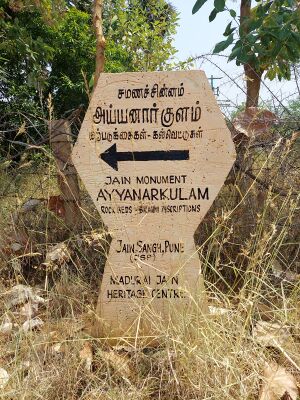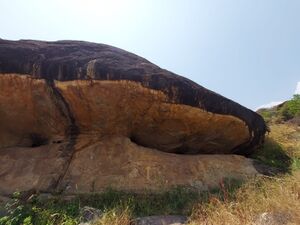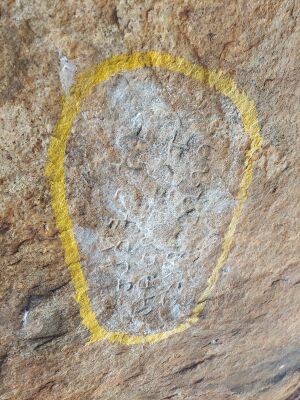Ayyanarkulam Hill Temple: Difference between revisions
(Changed Category to Standardized) |
Cyril.alex (talk | contribs) No edit summary |
||
| Line 1: | Line 1: | ||
{{Read Tamil|Name of target page=அய்யனார்குளம் குன்றுப்பள்ளி|Title of target page=அய்யனார்குளம் குன்றுப்பள்ளி}} | {{Read Tamil|Name of target page=அய்யனார்குளம் குன்றுப்பள்ளி|Title of target page=அய்யனார்குளம் குன்றுப்பள்ளி}} | ||
[[File:அய்யனார்குளம் சமணச்சின்னம்.jpg|thumb|''Ayyanarkulam Jain Monument'']] | [[File:அய்யனார்குளம் சமணச்சின்னம்.jpg|thumb|''Ayyanarkulam Jain Monument'']] | ||
Ayyanarkulam is a small village in the Ambasamudram Taluk in what used to be Tirunelveli district, and is now Tenkasi district. Here, in the natural caverns situated in the Rajaparai Hill, Samana ( | Ayyanarkulam is a small village in the Ambasamudram Taluk in what used to be Tirunelveli district, and is now Tenkasi district. Here, in the natural caverns situated in the Rajaparai Hill, ''Samana'' (Jain) rock beds and Tamil Brahmi inscriptions can be found. Tamil Brahmi inscriptions can also be found nearby in another hill called Nilapparai. | ||
== Rajaparai Cave Temple == | == Rajaparai Cave Temple == | ||
The temple was made in the Rajaparai for the Jain monks to stay in the rainy season. To prevent the water from getting in, a long channel has been cut in the entrance. | The temple was made in the Rajaparai for the Jain monks to stay in the rainy season. To prevent the water from getting in, a long channel has been cut in the entrance. | ||
The name of the person who had the rock beds for the Jain monks constructed is inscribed in stone here. It is a Tamil Brahmi inscription dating back to first century | The name of the person who had the rock beds for the Jain monks constructed is inscribed in stone here. It is a Tamil Brahmi inscription dating back to first century CE. The inscription is written in three lines in this cavern. | ||
[[File:இராஜப்பாறை குகைத்தளம்.jpg|thumb|''Rajaparai Cavern'']] | [[File:இராஜப்பாறை குகைத்தளம்.jpg|thumb|''Rajaparai Cavern'']] | ||
====== The Inscription ====== | ====== The Inscription ====== | ||
# Palli Seivithaan<ref>One who had the temple built. | |||
Palli means place of worship. Seivithaan means one who had something done. </ref> | |||
# Kadikai (Ko)vin magan | |||
# Perunkootran | |||
One can understand from this inscription that Perunkootran, son of Kadikai king had this temple built. | |||
== Nilapparai Cave Temple == | == Nilapparai Cave Temple == | ||
On the opposite side of Rajaparai, there is a tall rock shaped like a round pedestal. On top of this rock, a rock bed has been carved out, along with an inscription from the first century | On the opposite side of Rajaparai, there is a tall rock shaped like a round pedestal. On top of this rock, a rock bed has been carved out, along with an inscription from the first century CE. The name of the person who made the rock suitable for Jain monks has been inscribed on it as follows: | ||
[[File:இராஜப்பாறை தமிழ்பிராமிக் கல்வெட்டு.jpg|thumb|''Rajaparai Tamil Brahmi Inscription'']] | [[File:இராஜப்பாறை தமிழ்பிராமிக் கல்வெட்டு.jpg|thumb|''Rajaparai Tamil Brahmi Inscription'']] | ||
====== The Inscription ====== | ====== The Inscription ====== | ||
# Gunaavin Ilango | |||
# Seipitha Pali | |||
From this we are able to learn that Gunaavin Ilango had this temple built. | From this we are able to learn that Gunaavin Ilango had this temple built. | ||
== Rajaparai Cave Art == | == Rajaparai Cave Art == | ||
Few paintings have been discovered by the 'Yaadhum Oore Yaavarum Kelir’ ("All towns are ours, everyone is kin") group on the Rajaparai hill | Few paintings have been discovered by the 'Yaadhum Oore Yaavarum Kelir’ ("All towns are ours, everyone is kin") group on the Rajaparai hill. Gandhirajan and Balabharathi, researchers who research and document cave art have confirmed that these paintings are from the Great Stone Age and those are a new discovery. | ||
== References == | == References == | ||
[https://puthu.thinnai.com/%E0%AE%A4%E0%AF%86%E0%AE%A9%E0%AF%8D%E0%AE%A9%E0%AE%BF%E0%AE%A8%E0%AF%8D%E0%AE%A4%E0%AE%BF%E0%AE%AF%E0%AE%BE%E0%AE%B5%E0%AE%BF%E0%AE%B2%E0%AF%8D-%E0%AE%9A%E0%AE%AE%E0%AE%A3%E0%AE%B0%E0%AF%8D%E0%AE%95/ Jainism in South India – Puthiya Thinnai] | [https://puthu.thinnai.com/%E0%AE%A4%E0%AF%86%E0%AE%A9%E0%AF%8D%E0%AE%A9%E0%AE%BF%E0%AE%A8%E0%AF%8D%E0%AE%A4%E0%AE%BF%E0%AE%AF%E0%AE%BE%E0%AE%B5%E0%AE%BF%E0%AE%B2%E0%AF%8D-%E0%AE%9A%E0%AE%AE%E0%AE%A3%E0%AE%B0%E0%AF%8D%E0%AE%95/ Jainism in South India – Puthiya Thinnai] | ||
[[Category:English Content]] | [[Category:English Content]] | ||
{{ | {{Finalised-en}} | ||
Revision as of 08:26, 29 October 2022
இந்தப் பக்கத்தை தமிழில் வாசிக்க: அய்யனார்குளம் குன்றுப்பள்ளி
Ayyanarkulam is a small village in the Ambasamudram Taluk in what used to be Tirunelveli district, and is now Tenkasi district. Here, in the natural caverns situated in the Rajaparai Hill, Samana (Jain) rock beds and Tamil Brahmi inscriptions can be found. Tamil Brahmi inscriptions can also be found nearby in another hill called Nilapparai.
Rajaparai Cave Temple
The temple was made in the Rajaparai for the Jain monks to stay in the rainy season. To prevent the water from getting in, a long channel has been cut in the entrance.
The name of the person who had the rock beds for the Jain monks constructed is inscribed in stone here. It is a Tamil Brahmi inscription dating back to first century CE. The inscription is written in three lines in this cavern.
The Inscription
- Palli Seivithaan[1]
- Kadikai (Ko)vin magan
- Perunkootran
One can understand from this inscription that Perunkootran, son of Kadikai king had this temple built.
Nilapparai Cave Temple
On the opposite side of Rajaparai, there is a tall rock shaped like a round pedestal. On top of this rock, a rock bed has been carved out, along with an inscription from the first century CE. The name of the person who made the rock suitable for Jain monks has been inscribed on it as follows:
The Inscription
- Gunaavin Ilango
- Seipitha Pali
From this we are able to learn that Gunaavin Ilango had this temple built.
Rajaparai Cave Art
Few paintings have been discovered by the 'Yaadhum Oore Yaavarum Kelir’ ("All towns are ours, everyone is kin") group on the Rajaparai hill. Gandhirajan and Balabharathi, researchers who research and document cave art have confirmed that these paintings are from the Great Stone Age and those are a new discovery.
References
Jainism in South India – Puthiya Thinnai
✅Finalised Page
- ↑ One who had the temple built. Palli means place of worship. Seivithaan means one who had something done.



